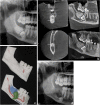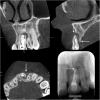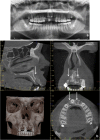Dentomaxillofacial imaging with panoramic views and cone beam CT
- PMID: 25575868
- PMCID: PMC4330237
- DOI: 10.1007/s13244-014-0379-4
Dentomaxillofacial imaging with panoramic views and cone beam CT
Abstract
Panoramic and intraoral radiographs are the basic imaging modalities used in dentistry. Often they are the only imaging techniques required for delineation of dental anatomy or pathology. Panoramic radiography produces a single image of the maxilla, mandible, teeth, temporomandibular joints and maxillary sinuses. During the exposure the x-ray source and detector rotate synchronously around the patient producing a curved surface tomography. It can be supplemented with intraoral radiographs. However, these techniques give only a two-dimensional view of complicated three-dimensional (3D) structures. As in the other fields of imaging also dentomaxillofacial imaging has moved towards 3D imaging. Since the late 1990s cone beam computed tomography (CBCT) devices have been designed specifically for dentomaxillofacial imaging, allowing accurate 3D imaging of hard tissues with a lower radiation dose, lower cost and easier availability for dentists when compared with multislice CT. Panoramic and intraoral radiographies are still the basic imaging methods in dentistry. CBCT should be used in more demanding cases. In this review the anatomy with the panoramic view will be presented as well as the benefits of the CBCT technique in comparison to the panoramic technique with some examples. Also the basics as well as common errors and pitfalls of these techniques will be discussed. Teaching Points • Panoramic and intraoral radiographs are the basic imaging methods in dentomaxillofacial radiology.• CBCT imaging allows accurate 3D imaging of hard tissues.• CBCT offers lower costs and a smaller size and radiation dose compared with MSCT.• The disadvantages of CBCT imaging are poor soft tissue contrast and artefacts.• The Sedentexct project has developed evidence-based guidelines on the use of CBCT in dentistry.
Figures















References
-
- Carter L, Farman AG, Geist J, Scarfe WC, Angelopoulos C, Nair MK, et al. American Academy of Oral and Maxillofacial Radiology executive opinion statement on performing and interpreting diagnostic cone beam computed tomography. Oral Surg Oral Med Oral Pathol Oral Radiol Endod. 2008 - PubMed
-
- Horner K, Islam M, Flygare L, Tsiklakis K, Whaites E. Basic principles for use of dental cone beam computed tomography: consensus guidelines of the European Academy of Dental and Maxillofacial Radiology. Dentomaxillofac Radiol. 2009 - PubMed
LinkOut - more resources
Full Text Sources
Other Literature Sources
Research Materials

